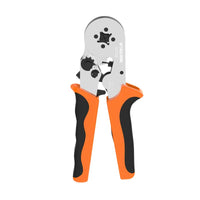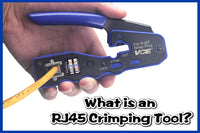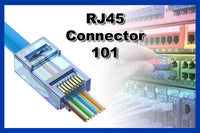Contents
It is sometimes necessary for home owners to handle various electrical wires for DIY projects or repairs. The best way to join these electrical wires is by using electrical connectors and crimping them properly. Using a quality wire crimping tool and the correct crimping are essential for good electrical connections. This article will cover a detailed, step-by-step tutorial to ensure strong and efficient connections.
What is a Wire Crimping Tool?
A crimping tool is a handy tool for joining wires and electrical components by compressing and tightening them. It typically features an ergonomic handle with one or more jaws. The crimping jaws are designed for different types of terminals or wire gauges. The strong pressure will deform the terminals and make them stick firmly to the wires. Many crimping tools on the market combine the function of both crimping, stripping, and cutting. There are two wire crimping tools commonly used for electrical connections: Terminal Crimpers and Ferrule Crimpers. Before knowing these two types of crimpers, you should firstly know what terminals and ferrules are.
Terminals vs Ferrules
Wire terminals usually have a metal barrel for crimping onto the wire end. These terminals come in different shapes, and ring terminals, spade terminals, and pin terminals are commonly used types. A terminal is often connected to a device or component.

Wire ferrules usually feature a metal tube that fits into the end of a wire. They are used to bundle and crimp multi-stranded wires. Wire ferrules look like pin terminals, but they have a slightly bigger metal tube that houses stripped wires. These ferrules are usually used to connect terminal blocks or connectors.
Introducing VCELINK Wire Crimping tools
VCELINK offers different types of wire crimpers for different purposes. These wire crimpers feature non-slip handles for easy operation. They are used to crimp different terminals and ferrules. VCELINK GJ710 is a versatile crimper combines the functions of crimping, cutting, and stripping; while VCELINK GJ709 has a ratchet self-adjusting design to crimp different terminal sizes. How to correctly use these wire crimping tools? Below is the detailed tutorial for using VCELINK crimping tools.
A Step-by-step Guide: How to Crimp Terminals and Ferrules?
Using GJ710 Wire Terminal Crimper
Step 1: Push the small blue slider to leave the length of the wire you want to strip, which is usually 1/4 inch. Make sure that the stripped length of wire is approximately equal to the insulation of the ring terminal.

Step 2: Rotate the tensioning wheel to adjust the proper jaw pressure. You should turn clockwise to tighten the jaw pressure.

Step 3: Put the wire into the stripping jaw of the crimping tool and tightly squeeze the handle to strip the wires.

Step 4: Insert the bare wire into the ring terminal until it reaches the end of the barrel.

Step 5: Put the ring terminal into the appropriate crimping cavity and tighten it.

Step 6: Done! You can test the tension by gently tugging the ring terminal.

Using GJ709 Wire Crimping Tool
Step 1: Strip off the insulation the same length as the front metal tube and put the bare wires into the wire ferrule.

Step 2: Insert the ferrule into the crimping jaw. You just need to put the metal tube of the ferrule into the jaw.

Step 3: Press down firmly.

Step 4: Complete crimping. You can test the tension by pulling the wire ferrule.

Tips for Correct Wire Crimping
Poor wire terminal crimping can lead to unreliable and weak connections. Here are some tips for correct wire crimping.
- You should select the right crimping tool. Wire crimpers are designed for crimping different types of terminals and ferrules. In addition, make sure that the wire crimper can support the wire gauge and terminal size.
- Choosing a wire crimper that also include stripping and cutting functions may simplify your operation and enhance efficiency.
- Test the tension after finishing crimping. You can gently tug the terminal to check if the connection is secure.
- You can also test the electrical connection using a multimeter continuity tester.
Final Thoughts
Learning how to crimp wires properly is important for the success and safety of your project. This article provides a comprehensive guide to the tutorial and tips for reliable wire crimping.
For more information on this topic, you can keep up on our blogs. While VCELINK offers general and basic information for our customers and other visitors to the website, it’s not professional advice.






Be the first one to comment.
Leave a comment